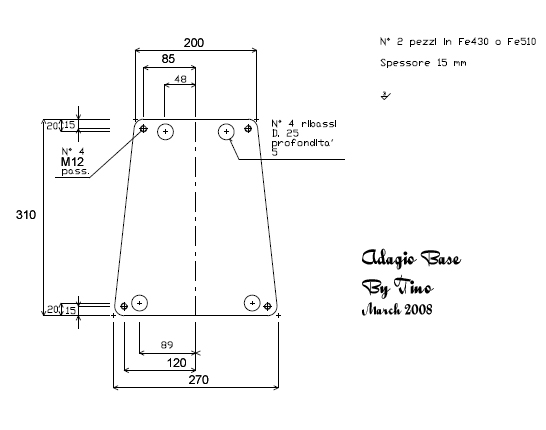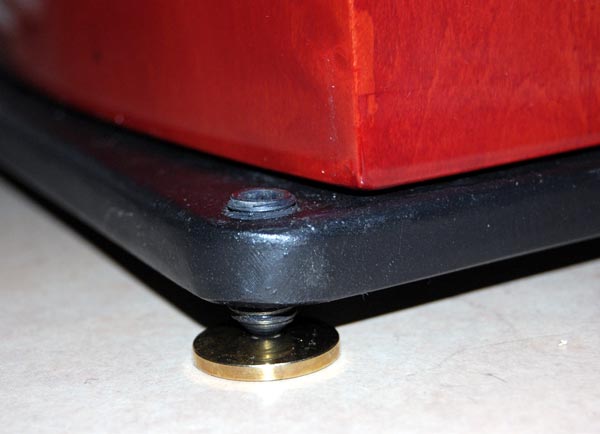
An AZ ADAGIO basement:

I have to be honest: I have designed this project not to improve the sound quality of my Acoustic Zen Adagio loudspeakers, but to improve their static stability!
In fact, you have to know that the original AZ Adagio spike (a screw which goes inside the wooden base plus a cone which come out, with a variable height) are fixed inside the footprint of the speaker and that is not the best configuration to assure the static stability of these high towers, in particular if you have small babies or large pets.
From here I started to design a cheap way to improve the stability from any possible lateral hit. It was clear that I have to move the spikes out of the Adagio footprint, but possibly not to far to maintain at a reasonable level the space occupied. The simplest solution was to build an iron base larger than the Adagio footprint and to place four (three is too dangerous!) screws with a conic point close to the base vertex. Here the main problem: the original Adagio screws are fixed in an iron base, which comes out of the wooden base of about 2-3mm. So, if you take out the Adagio screws, then the loudspeaker will not lay on all its wooden base, but on the four annular screw-holder. Then the new Adagio Base should have four big holes (at least 4mm deep) where these iron rings can enter, so that all the wooden base will be in contact with the new base. From this reasoning it comes the design that you can see in the first figure, where the four 25mm holes (only 5mm deep) are made for this purpose. The new iron base is 15mm thick.
|
|
|
To be sure that the new 25mm holes will fit exactly the original spikes position I have taken a 1:1 footprint and draw the base profile around it. You can also put the iron base above the original spikes (figure on the right) and draw the exact centers of the holes directly on it.
|
|
|
|---|---|
|
|
|
To be sure that the Adagio wooden base is well fixed on the new iron base I have used some Bostik Blu Tack and some Grey Takt (from the Suono journal). To avoid damages on the ceramic floor I have used under my screws four expensive G&BL High Power 522 golden bases (about 20 Euro the set of 4).
|
|
|
 The
final result is a trapezoidal black 31x 20(min)27(max)x1.5 cm base
with four screw that you can use to fine tune the level and four
golden discs under the screws. The weight is about 8 kg each base.
The total cost is in the 100-150 Euro range. In this way the static
stability has been improved a lot, but what about the sound?
The
final result is a trapezoidal black 31x 20(min)27(max)x1.5 cm base
with four screw that you can use to fine tune the level and four
golden discs under the screws. The weight is about 8 kg each base.
The total cost is in the 100-150 Euro range. In this way the static
stability has been improved a lot, but what about the sound?
 Well,
I have to admit that also the sound have changed. It seems to me that
the bass are tighter and that the soundstage is even more
focused than before. If I have to find a defect, maybe that the
bass is a little “less clean” than it was with the AZ
spikes, but it seems to me that the advantages are better than this
eventual defect. And the Adagio are more stable than they were
before!
Well,
I have to admit that also the sound have changed. It seems to me that
the bass are tighter and that the soundstage is even more
focused than before. If I have to find a defect, maybe that the
bass is a little “less clean” than it was with the AZ
spikes, but it seems to me that the advantages are better than this
eventual defect. And the Adagio are more stable than they were
before!
Tino © March2008